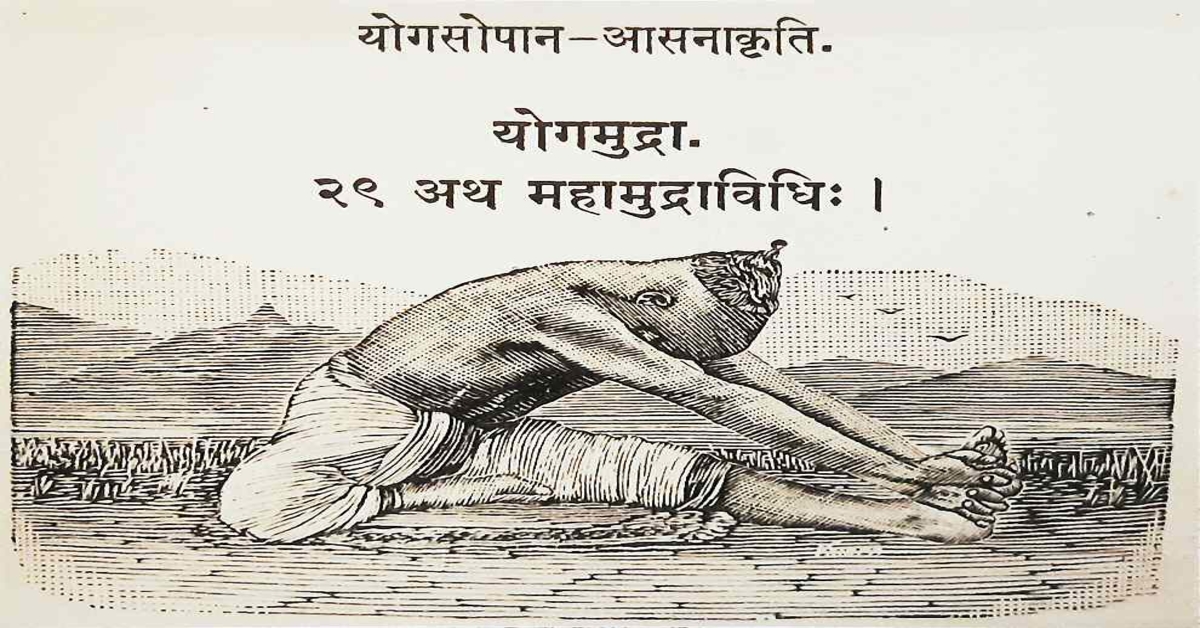Maha Mudra is also called the great psychic attitude. It belongs to a class of mudras called Bandha mudras or lock mudras. Lock mudras combine bandha along with a mudra.
To learn the definition of what is a mudra check this article.
Maha mudra along with other Bandha mudras charge the system with prana (vital energy). This helps in preparing the body for the great Kundalini awakening.
Techniques belonging to the category of lock mudras are:
- Maha Mudra
- Maha bheda mudra
- Maha vedha mudra
Scriptural Reference of Maha Mudra

Translation
“Firmly press the anus onto the left ankle, extend the right foot, hold the toes with the hands, contract the throat, and look between the eyebrows. Inhaling repeatedly, fill yourself completely with air. This is called Mahamudra.”[1]

Translation
“It can cure wrinkles and gray hair, old age and death, consumptive cough, constipation, disorders of the spleen, decrepitude, and fever. By mastering Mahamudra, the yogi can get rid of all diseases.”[1]

Technique – 1 (Advance)
Starting position or Base Position: Utthanpadasana (stretched leg pose)
- You need to sit down with the legs outstretched.
- Bend the left knee and then press the left heel firmly into your perineum or vulva (mooldhara chakra). The right knee needs to remain outstretched.
- Place both of your hands on the right knee.
- Bend forward enough so that you can grab the right toe with both your hands.
- Hold the position for as long you feel comfortable.
- Return to the upright position (step 2) and rest both your hands on your right knee. This makes for 1 round.
Duration
Practice 3 rounds with a left leg folded, 3 rounds with right leg folded, and then finally outstretch both of your legs and practice 3 more rounds.
After you have become comfortable with the above position (Utthanpadasana) then only you should practice Maha Mudra which is the evolution of the previous exercise.
Prerequisite
Before practicing maha mudra one should be proficient and well trained in the techniques of shambhavi, khechari, moola bandha and kumbhaka. This practice is best attempted with an expert’s guidance. One should avoid practicing it without guidance.
Maha Mudra
- Position yourself in utthan padasana with your right leg outstretched. Keep your back straight, all the while be sure you are relaxed.
- Then perform kechari mudra.
- Then take a deep breath in through your nose.
- While you exhale, bend forward and grab the right toe with both your hands.
- Keep your head erect and back straight as much as possible. Then slowly inhale and tilt your head back slightly.
- Perform shambhavi mudra and then moola bandha.
- With your breath held inside, rotate your awareness first to the eyebrow centre (ajna chakra), then throat (vishuddhi chakra), then to the perineum (mooldhara chakra) and then back to the eyebrow centre. At each chakra, your concentration should remain for 2 to 3 seconds.
- Continue to rotate your awareness as long as you can hold your breath without straining.
- Release shambhavi mudra and moola bandha. Relax and slowly exhale, returning to the upright position (step 1). This completes 1 round.
Duration
A beginner can practice 3 rounds with left leg folded, 3 rounds with right leg folded and then finally outstretch both of your legs and practice 3 more rounds.
For any more increase in duration an expert’s guidance is necessary. Though slowly after enough practice and time one can at maximum increase from 3 to 12 rounds each.
Time of practice
This mudra is best performed early in the morning while the stomach is empty, and the bowels have been emptied.
Base Position Variation: Siddha/siddha yoni asana
Instead of utthanpadasana one can also be in Siddha/siddha yoni asana. The hands should be jnana or chin mudra. One needs to practice in the same way as the above steps but without bending forward. The rounds and duration will remain the same.
Technique – 2 (Basic)
Down below is a basic version of maha mudra without shambhavi and kechari. A beginner can practice it. This is also equally beneficial but obviously not as powerful as the advance version involving kechari and shambhavi mudra.
Precautions
- Do not strain your lungs while retaining the breath. The length of breath retention should be increased very gradually after you have been practicing for months, sometimes even years.
- People with high blood pressure and heart problems should not perform this practice.
- People with any serious medical ailments should first consult with their doctor and then with their yoga teacher before practicing.
- This practice generates a lot of heat in the body and so should be avoided during summer.
Benefits
- Combined benefits of moolabandha, khecari mudra and shambhavi mudra are gained by this practice.
- Digestion improves and digestive ailments are relieved.
- It charges the whole system with prana energy and thus increases awareness. It can even induce spontaneous meditative state after the practice is complete.
- It helps in alleviating mood as energy blockages are removed.
References
- Book: The Gheranda Samhita: The Original Sanskrit and an English Translation, edited by James Malinson
- Book: Asana Pranayama Mudra Bandha by Swami Satyananda Saraswati
- Book: Hatha Yoga – The report of a personal experience, by Theos Bernard
- Book: Anatomy of Hatha Yoga A Manual for Students, Teachers, and Practitioners by David H. Coulter

Nice article. 👍🏼